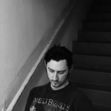Albert Bierstadt Was Always Botox
Today the Department of Homeland Security, headed by the comely Kristi Noem, posted a picture of one of my favorite paintings.
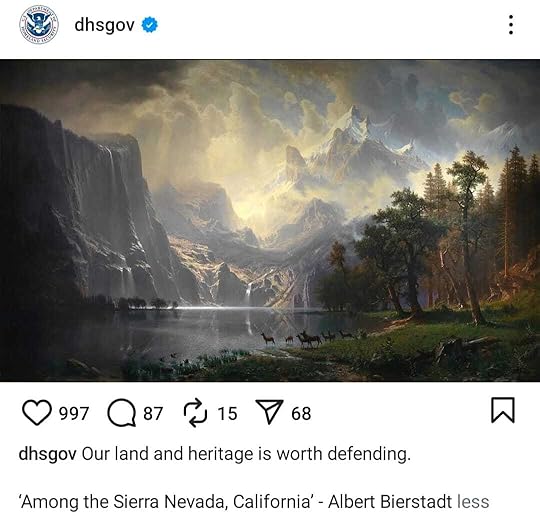
I suppose Kristi must imagine that a few months ‘among the Sierra Nevada’ is all the National Guard would need to restore ravaged and chaotic California to its former splendor. But Bierstadt, like Krisi, was mostly selling fiction. None of old Albert’s cosmetic creations ever made it to market without, first, a thick fat basecoat of Botox. And let’s be honest, the only thing that might beautify this great nation today is if the National Guard were carrying the trash that is the Trump family out of DC in those big industrial Glad Bags.
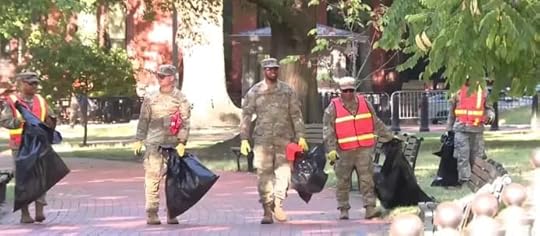 National Guard in DC on WednesdayFor your morose delectation, I have included my full comment on the Department of Homeland Security’s post below. Please enjoy.1
National Guard in DC on WednesdayFor your morose delectation, I have included my full comment on the Department of Homeland Security’s post below. Please enjoy.1
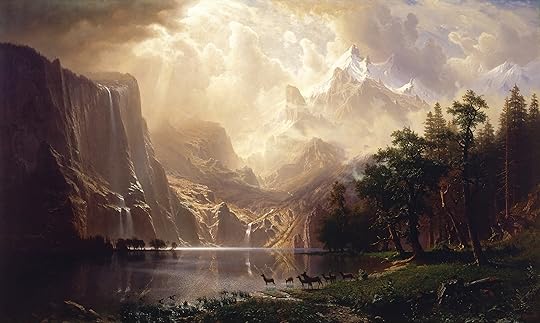
Dear Kristi, whereas previous works name specific sites like The Domes of the Yosemite, or Lander’s Peak, here Bierstadt leaves the locale of his Sierra Nevada, a mountain range eighty miles wide and five times longer, mysteriously vague. And yet even knowing it depicts no true mountain view, I suppose Bierstadt might easily be forgiven. If the landscape painter’s task is, as Ruskin insisted, to “direct people’s attention accurately to the beauty of God’s work in the material universe,” then the painting is unquestionably successful, for although the technicolor mountains, inflated to a height beyond hyperbole, certainly do not exist in California’s Sierra Nevada—as someone once employed by the US Forest Service building trails in the Sierra, I might know—one must assume, given theoretical physicists increasing insistence on an infinite number of possible worlds, that they do exist in some corner of ‘the material universe,’ even if that corner does not include the planet Earth. Not so much a composite as a work of fantastical art, Among the Sierra Nevada perhaps has value as a kind of proto surrealism, pointing the way toward the science fiction visions of, say, H.R. Giger or Zdzisław Beksiński, postwar painters of alien worlds and landscapes where bones, bodies, and machinery continually combine and entwine, expanding and building forever outward toward some inscrutable purpose one is happy never to fathom. And in fact, in Bierstadt’s Sierra, the snowy slopes rising above the emerald valley floor, receding and ascending over further terraces and balconies into increasingly swollen heights everywhere pierced with outlandish slanting spires, teetering pinnacles, and bony buttes do eventually begin to suggest, more so than any realistic mountain landscape, something gathering its limbs, struggling for birth as it strives to push its brittle bones through the pale tissue of some kind of pyramidal egg sack. Rays of gold project through a dome of swirling cloud, showering the scene in what Bierstadt must have intended as some kind of heavenly light, although the longer you stare at the painting the easier it is to imagine the blinding glare emanates from the descending eye of some kind of malevolent drone come to harvest another hatchling deformity from the smoldering hive. Disney illustrators working beside the Los Angeles River in their Burbank offices would later study such nightmare effects in eras before the advent of CGI. And yet I have a feeling that today, behind the fantasia, we might find nothing more than another Jurassic shipping crane stretching its limbs. Certainly, Bierstadt required the advent of some sort of similar implement as the gigantic ten by fifteen-foot canvas went trotting all over Europe, from Rome to London, Paris to Moscow, and Berlin’s Royal Academy where it won the Exhibition’s Gold Medal. At the very least, the painting reveals that by 1868 Alfred Bierstadt had stopped seeing what was actually there. Mark Twain himself had already admitted as much. In 1867, perhaps finally grasping that ‘intelligible something’ he found so maddening in Church’s Andes, he mocked Bierstadt’s Domes of the Yosemite, calling it “very beautiful, considerably more beautiful than the original.” Ambrose Bierce cut deeper, glimpsing beyond the theatrics something abominable and grotesque struggling for birth. “It is with grim satisfaction,” he mocked, “that we record the destruction by fire of Bierstadt’s celebrated picture of Yosemite Valley. The painting has been the prolific parent of ten thousand abominations.” An early mountaineer of California’s Sierra Nevada, Clarence King, likewise found Bierstadt’s mountains too lurid, flimsy, and finally just fake. He wrote in 1872 that “It’s all Bierstadt and Bierstadt and Bierstadt nowadays! What has he done but twist and skew and distort and discolor and belittle and be-pretty this whole doggonned country? Why, his mountains are too high and too slim; they’d blow over in one of our fall winds… He hasn’t what old Ruskin calls for.” On a deeper level, though, beyond the charge of infidelity, Bierstadt’s desperately exaggerated summits, the endless unfurling hulk of their unrealism, their too high and too slim peaks crowned with improbable protruding mountain horns—they do not lift a song of God’s glory or the Country’s inexhaustibility. “O beautiful for spacious skies… For purple mountains’ majesties…” In fact, by what Alan Watts might call The Law of Reversed Efforts, they whisper just the opposite. Even the deer at the foreground of the painting seem to hear it. They stand frozen beside a silver stream, ears pointing, listening as they peer alarmed, away from the light, toward something in the forest outside the painting’s frame. What do they hear? What might they see? It’s hard to say, but I believe it’s what Blakelock finally saw. A conviction that sunk to the depths of his marrow long before he touched California’s shores. Something visceral that urged him away from realism, and eventually, beginning in the 1880s, before he went insane, compelled him to utilize the color black more than any other painter in history. You can see it, too, albeit indirectly, in Bierstadt’s Sierra, which means saw, from the Spanish serra. The painting reveals unconsciously, precisely through all its striving heights, a dark underworld of doubt, a lurking suspicion, indeed the mounting dread and creeping terror that the palace of Nature may not be the benign and limitless monolith once pretended. And the voice outside the frame that whispers to the startled deer? It is just what we have most to fear. The voice is our own, the approach of Man, bearing the ravages of the axe and saw…
The above is an excerpt from my third book, which—somehow, yes—is about the 1959 nuclear meltdown at the Santa Susana Field Laboratory at the end of Los Angeles’s San Fernando Valley.
Soon I’ll post a longer excerpt from this insane section of the book that bridges the bits hinted at from my previous El Aliso post, connecting Bierstadt and the Hudson River School painters to the Los Angeles River and the trauma and genius of an even better artist, Ralph Albert Blakelock.
I’ll remind you: the headwaters of the Los Angeles River begin at and flow off of the irradiated, alien-looking hills of the Boeing-owned Santa Susana Field Laboratory…
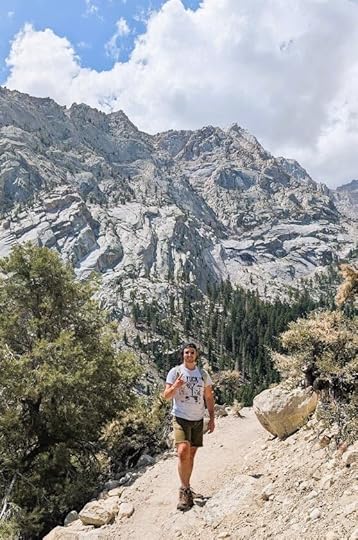 The author among the Sierra Nevada last month
The author among the Sierra Nevada last monthDumpster Fires is a beacon of light in a world of trash and sorrow. To receive new posts and support my work, consider becoming a free or paid subscriber.
1This post is a paid advertisement for Gustavo Arellano.
Dumpster Fires
@ https://dumpsterfires.substack.com/
Dumpster Fires is your definitive guide to the catastrophic homeless crisis unfolding outside certain windows in Los Angeles. It's also where a Follow on Substack
@ https://dumpsterfires.substack.com/
Dumpster Fires is your definitive guide to the catastrophic homeless crisis unfolding outside certain windows in Los Angeles. It's also where award-winning "weird" nonfiction writer Barret Baumgart cooks up new plagues of uncanny research exhumed across California's Mojave Desert and the wasteland of Los Angeles for the morose delectation of a limited but discerning literary readership. "This infected light saved my life!" -Rob ...more
- Barret Baumgart's profile
- 10 followers


